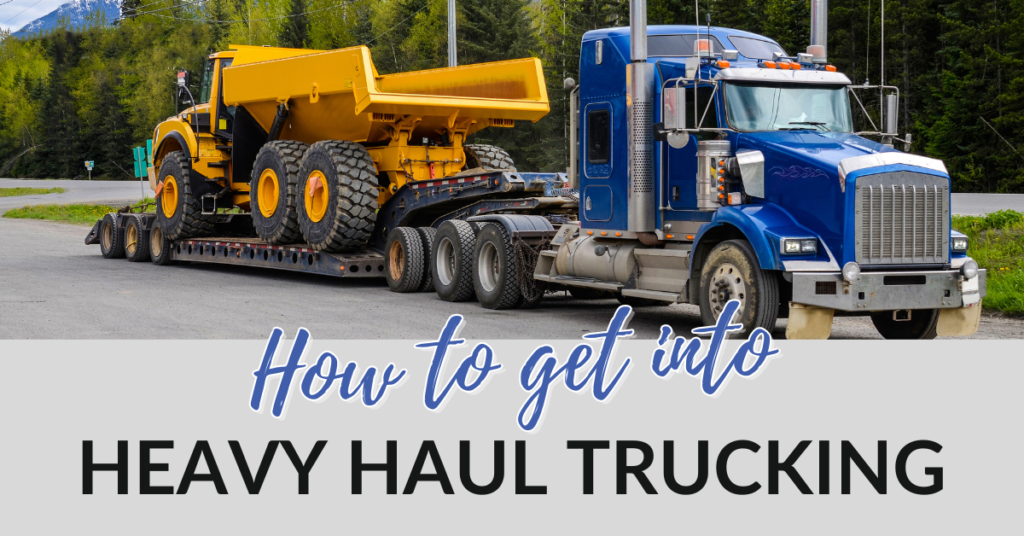How to Get Into Heavy Haul Trucking
We’ve all seen them chugging slowly down the highway. You can’t miss the big yellow banners that say “OVERSIZE LOAD” or the four red flags blowing in the wind. You might’ve even seen a few blinking lights.
There you have the handiwork of heavy haul truckers, hard working men and women who transport items that are classified as heavy haul loads – more than 8.6 feet wide, more than 13.6 feet tall, longer than 53 feet, and heavier than 80,000 pounds of gross weight. Heavy haul truckers can move just about anything, from a wind turbine blade to a small house. Popular heavy loads can be construction machinery, road repair parts, military equipment, and airplane components.
Building a successful heavy haul trucking company is all about having the right equipment, getting the required permits, and using the proper safety indicators. When starting a trucking company and choosing to specialize in heavy hauling, there are no special authority designations needed. So, let’s look at what you do need to keep your heavy haul trucking career on steady lanes.
What Equipment Do I Need for Heavy Haul Trucking?
Trailers: There are a variety of trailers designed to support heavy haul loads. Here are a few of the more widely used examples:
-
- Step deck – Perhaps the best-known specialized flatbed trailer, which is also called the single drop deck, is commonly used for tall loads.
- Removable gooseneck (RGN) – The detachable neck helps create a ramp that is handy for heavy vehicles and equipment.
- Double drops – These are also called lowboys and are good for construction equipment, tanks, forklifts, and trucks.
- Stretch trailers – Some call them telescopic trailers because they can be adjusted to the size needed for the heavy load.
Axles: No matter your trailer, axles are the determining factor on your legal load capacity. These rods or spindles that pass through wheels are key to heavy hauling. Always keep in mind that you should consider if adding more axles will legally allow you to support heavier loads.
- Steer axles – They cannot carry more than 12,000 pounds.
- Single axles – If you have only one axle at the front or rear, it can only support 20,000 pounds.
- Drive and tandem axles – If you use the tandem axles setup, which is two axles no more than five feet apart, you can legally carry 34,000 pounds. But if you only use one drive axle, you wouldn’t reach that legal limit.
What Permits Do I Need for Heavy Haul Trucking?
When it comes to permits for hauling heavy loads, there are two facts to know up front – every state requires a permit to move heavy loads, and you must always have your heavy load permit handy just in case you need to show it to authorities.
The rest is dependent on the state, the size of the cargo, the travel itinerary (or movement plan), and your supporting equipment. Here are other facts about permits for heavy loads:
- Always make sure to get the right movement permit for what you’re hauling.
- You must submit a movement plan, cargo details, and time estimates.
- Holiday, weekends, and seasons may affect your permit parameters and travel allowances.
- States will take population density, environment, local terrain, and local laws into account before issuing a permit.
- Permits are usually issued within 3-5 days after applying and they are valid only for the specific heavy load.
What Safety Components Do I Need to Get a Heavy Haul Permit?
You can also call these safety indicators since they are essentially visible signs that you are hauling a heavy load.
- Banners – They are large, long, and yellow with black letters that spell “Wide Load” or “Oversize Load.” They are perhaps the most recognizable visuals of a heavy load on the highway.
- Safety flags – Like the banners, these are also instantly recognized. Bright red or orange flags, one on each corner of the loaded hauler, map out the space of the heavy load in motion.
- Guide cars – Pretty self-explanatory, right? It’s an escort vehicle, always clearly marked, that helps manage the traffic surrounding the heavy load especially in busy highways.
- Lights – Flashing or rotating, usually yellow, is the indicator to other drivers that a heavy load is traveling at a slower speed than usual traffic.
How Do I Find Heavy Loads?
Finding heavy loads to haul is much like finding any kind of load to transport. Load boards, such as NextLOAD.com, which has a search by weight feature, are great ways to find heavy loads. Also, networking and negotiating business relationships could get you steady heavy loads to haul from specific shippers and brokers. Working with a reputable freight factoring company could also prove beneficial to keep the cash flowing so you can confidently haul more heavy loads.
Now that you know all about the world of heavy haul trucking, become a NextLOAD.com user and find a great heavy load by using the search by weight feature. Create your FREE account on NextLOAD.com and start searching for big money heavy loads now.
